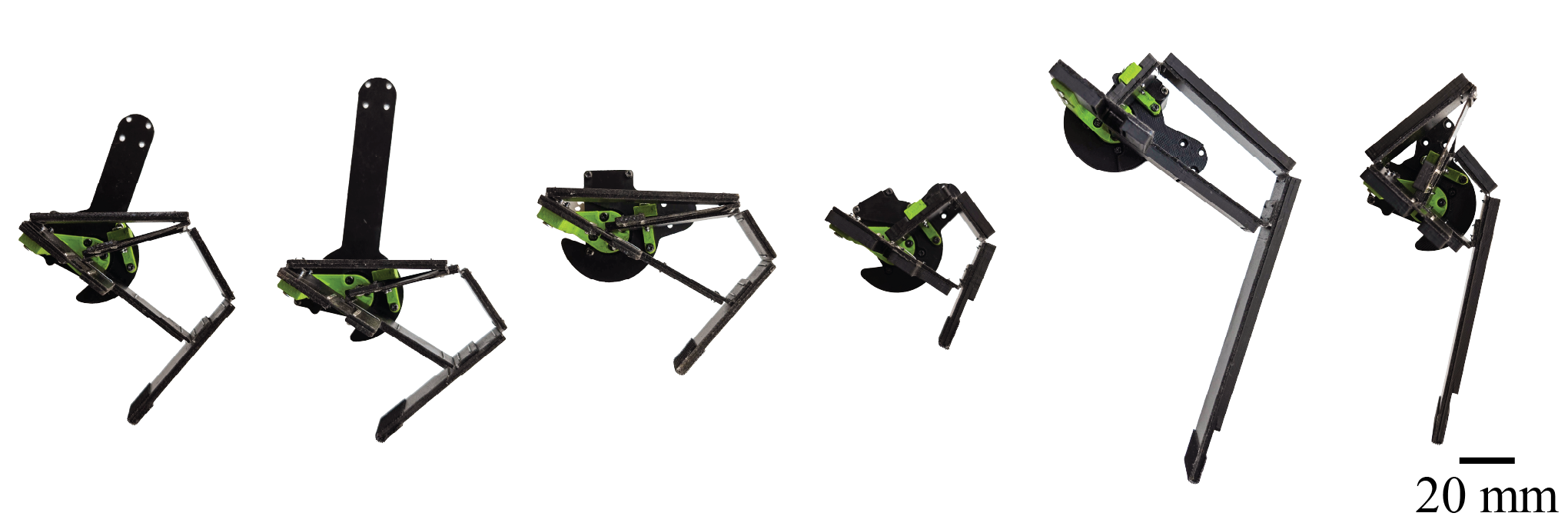Abstract
Having a well-rounded fixed leg design for a quadruped inevitably limits performance across diverse tasks, while tunability enables specialization and leads to better performance. We introduce a sub-500-gram quadruped robot with a rich leg design space. Reinforcement learning is used to train a locomotion policy that works across designs and exploits their unique dynamics. It also enables mapping from designs to task performance, where interpretable and insightful performance trends and design principles emerge.
With two papers, we showcase the proposed methdos in selecting leg designs for two distinct tasks: pure locomotion, such as running and turning, and force-based locomotion, such as pulling, pushing, and carrying payloads.
The fast running design reaches a maximum speed of 0.7 m/s or 5.4 body-lengths per second, and the efficient design has a cost of transport of 0.3. The top performer in pulling walks at 0.5 body-lengths per second while exerting a force that is almost 60% of its weight.
Tunable Legs
The proposed leg design has a range of tunable design parameters, including leg length, foot travel, transmission ratio, and passive parallel and series stiffness. Thanks to laminate design and fabrication techniques, it is also straightforward to model, low-cost, and fast to manufacture. Its feasible leg design space can be spanned with a “flood fill” algorithm. 400 designs were generated and 6 designs were made.

Design-aware Policies
Two locomotion policies are trained separately for the pure and force-based locomotion with reinforcement learning. Both of them observe leg designs to adapt to the different dynamics. Curriculum strategies, also similar to “flood fill”, are employed to gradually increase the design-dependent task difficulties, so that each design’s physical limits can be identified and reached.
Trend Discoveries
With the learned polices, performance can be evaluated in simulation and analyzed against design parameters. Two most notable trends are: there is an optimum passive series stiffness for locomotion, and the longer the legs the more efficient the locomoiton. Although these trends have been discovered in biomechanics or robotics, we believe they showcase the potential our proposed methods in discovering robot design principles while considering their controls.


Physical Validations
Three designs for each locomotion type were fabricated and tested in the real world. Their performance aligns relatively well with the selection intentions. Quantitative mismatches do exist due to various Sim2Real gaps.
We also tested some designs in less controlled environments by remote controlling them to traverse different terrains. The learned policy is quite robust against slippages, slopes, drops, and gaps.
BibTeX
@article{chen_curating_2025,
title = {Curating Tunable, Compliant Legs for Specialized Tasks},
author = {Chen, Fuchen and Aukes, Daniel M.},
journal = {The International Journal of Robotics Research},
year = {2025},
}
@inproceedings{chen_informed_2025,
title = {Informed Repurposing of Quadruped Legs for New Tasks},
author = {Chen, Fuchen and Aukes, Daniel M.},
booktitle = {2025 IEEE International Conference on Robotics and Automation (ICRA)},
year = {2025},
}